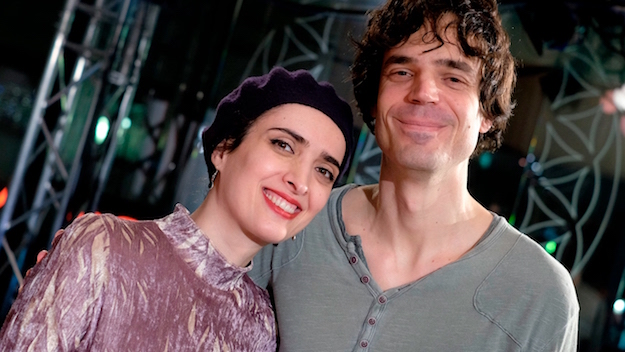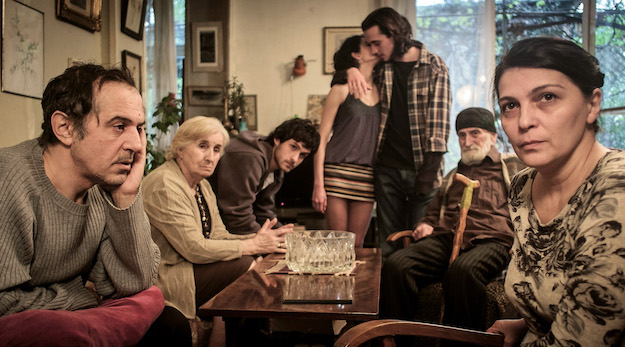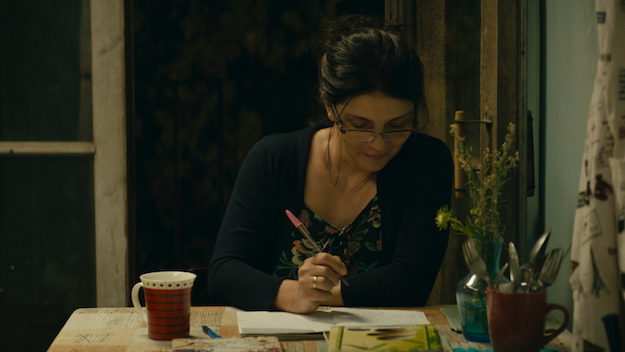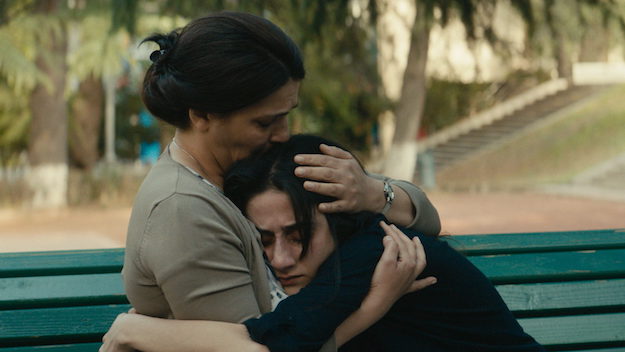My Happy Family marks the director couple’s second feature; In Bloom (2014) tracked two teenage girls struggling to navigate what narrow and fraught paths toward agency Georgian society allowed in the 1990s. Fast-forward to the present, and My Happy Family finds its protagonist, Manana (Ia Shugliashvili), world-weary but clear-eyed. Following the unexpected advice of a student in her class, Manana flabbergasts three generations of her family by electing to move out of their cramped home and rent her own apartment. Ekvtimishvili and Gross’s lightness of touch allows plentiful moments of black humor to break through during even the family’s most explosive fights. Manana’s mother, Lamara (Berta Khapava), whose melodramatic posturing outsizes her frail frame, is a particular delight. My Happy Family abounds in accomplished long takes, which capture the fullness of relative newcomer Shugliashvili’s performance as Manana: the camera adeptly tracks Manana through family gatherings, mapping her family home as a heavily subjective space. Film Comment spoke with Ekvtimishvili and Gross just prior to their film’s screenings in New Directors/New Films on March 19 and 21. My Happy Family is now available on Netflix. While your last film, In Bloom, follows teenage girls coming of age and discovering the constraints of a patriarchal society, the protagonist of My Happy Family is a grown woman who is already a weathered survivor of those societal pressures. It seems like a natural progression. Nana Ekvtimishvili: Yes, their topics are both Georgian women; they are teenage girls, and they grow into adults. If you want to draw parallels, it’s easy to do because at some points [in My Happy Family] Manana is treated by her society and her family like a teenage girl. They’re both generally about how the lives of Georgian women were in the 1990s, or nowadays—when they are 14 and when they have already lived more than half a century. Women stay women and they have to fight in Georgian society. Manana’s attempt to separate herself from her omnipresent family and stake some space of her own is an ordeal that takes up the entire film. In In Bloom, we don’t know how successful those characters are after the film’s story concludes, but Manana clearly manages to exert her independent willpower against her family’s wishes. NE: Yes. The protagonists of In Bloom are very, very intuitive. They are not so cautious, they do more risky things because they are still children and they are following their instincts. They don’t know what sexual lives are, they don’t know what marriage is, they want to discover things. As for Manana, she already seems to know everything. She has two grown children, she is a woman, she has a husband, she has a job. But though she is a grown woman, she has this inner voice that until now she has not had the chance to raise fully. Or to lead her life the way she wants to lead it—to live unattended, to have her own room, her own space. A room of her own, as it’s called in Virginia Woolf’s essay.
My Happy Family pointedly explores the weight of tradition as embodied by three generations living in one house. Patterns develop throughout the generations—Manana finds out about her husband’s infidelity not long after she finds out that her son-in-law has been unfaithful to her daughter. But she also clearly demonstrates her ability to stubbornly pave her own path. Can you speak a bit about how individual will and tradition interact in the film? Simon Gross: The traditional Georgian family, with three generations living together in an apartment that is a bit too small for so many people, is quite normal. Especially in Manana’s generation, it is getting more common for younger people [to live alone]. That a woman like Manana would leave her family because she wants to live alone beginning in her early fifties completely unusual. Lamara, her mother, and even the kids totally cannot understand at the beginning why she wants to do this. As her son asks her: “What do you want? It’s so nice here.” He simply cannot understand because it doesn’t seem so obvious at the start. This is not the tradition and not how women are supposed to live. Her place is really meant to be the family and not on her own. NE: Somehow My Happy Family reflects one relationship between a man and a woman. We have several couples: Manana and Soso, Lamara and Otar, Lahko and Nino, Lasha and Kitsi. We have Manana’s student Tatiana [and her ex-husband]. These six different relationships somehow show one relationship at different stages. For example, we have a frustrated couple like Lamar and Otar, who have lived together for more than 50 years and fight with each other constantly, who cannot feel the joy in life anymore. Otar wants to die, and Lamara is constantly complaining that he was not a kind husband and that she had such a tough time with Otar in comparison with what Manana has had with her husband. So we have Manana and Soso in the middle stage, where things went wrong. But now they have a family, and they’re together. We have Nino and Vahko, which is a fresh, passionate love from Nino’s side. She wants to get pregnant and have his child. We have the very, very naïve love between Lasha and Kitsi. They don’t think about what kind of family they each come from or if they have money, if they have jobs, if they have educations. They just want to be married and to be together. We have Tatiana, Manana’s student. She somehow made a misstep and divorced her husband. So this is a kaleidoscope—you see the very, very complex and difficult relationships in Georgian families from the perspective of age. What Lasha and Kitsi have now, Manana and Soso also had once. During the film we discovered the beautiful and sad sides of these relationships. In both In Bloom and now My Happy Family, Nana writes but you both direct. Simon, at what point in the project do you come on? How do you approach sharing directorial duties? NE: In the early stages of scriptwriting, we start talking about the film because we know that we want to make it together. So I write the script but from draft to draft, but it’s still a close relationship between us as directors. Deciding what the action is, who the characters are, what story we want to tell and the look we want to achieve in the film. For example, for this film we knew early that it would be shot in long takes, so that had an impact on the writing and how we imagined scenes. When the script is ready, we start to cast the film and finance it. Each step we do together, through the end—with shooting and postproduction. We are one team and we try to do it all together. SG: The writing process somehow works together with the long casting process. With this film and the previous film, it took almost a year to complete the casting process and rehearsals. It’s a good time to get new ideas and to check what needs work. Often actors bring great dialogue when they start to understand the role. NE: Yeah, you might have actors who speak differently than you have written in your script, so you can use the actor to check your dialogue and to see if it fits the actor well.
I loved your use of long takes in this film, where the camera would just follow individual characters around throughout the length of entire scenes. Why did you see the film in long takes so far ahead of time? SG: Well, the main idea is that we really like the mise-en-scène and the actors. We have the two of them first, characters moving in the space, and put the camera in after that. We don’t come to the set and say, okay, today I need 20 shots, and first we do the master shot and then we shoot the face and so on. We don’t like that kind of technical approach. On a shooting day, we don’t shoot during the first part of the day because we need so much time to build the mise-en-scène, to figure out who’s taking to who where. So that gives the actors more space. And for us it’s really important not to think about the camera at first, but to think about the scene first. What is the scene really about? What actions should the actors have? Then the camera comes in and we do a full rehearsal and the full scene with the camera. We try different things out. During the process, if it works, we really start to get at the point of the scene. Of course, theoretically we know it from the script but when you start working—it’s such a different part of the work. To give yourself room to work is really important to us. You’re capturing a family and how they interact in their space. The setting is so much a part of it—the cramped living quarters, everyone on top of one another. SG: You need to make a lot of decisions that you would classically make in editing. If you shoot in one shot, you cannot show everything. Sometimes you don’t need to see everything, and sometimes it’s okay just to see somebody’s back for a long time. It can even be emotionally stronger. You edit, in a way, in the camera already. Which is, of course, also risky later, if it doesn’t work. NE: The most important part of this kind of shooting is that you are forced, as a director, to develop your relationship to the scene and the story. Because it’s not just the shooting, it’s not just recording things with the camera and then in the editing room deciding how to cut, how to create. You’re forced, really, to know what story you want to tell with this kind of shooting. So you develop your relationship to the main character, to other characters, to the space, to the atmosphere, to everything. The scene makes sense, because you’ve really prepared it. You know what you want to say and how you want to show the scene to the audience. You don’t shoot quickly with no time and make decisions later on; no, you have to decide during the shoot, as the actors are moving through the space. I found one particular shot of Manana’s back particularly affecting: after the biggest family argument in the film, we cut to Manana cutting herself cake in her new apartment and relaxing in her easy chair with her back to the camera. The camera has just finished tracking her relentlessly throughout the entire previous scene, so when it finally sits and leaves her alone, it creates an incredible sense of peace. SG: The scene before that, where she sees her relatives, was one of the most difficult scenes to shoot because there are so many characters and it’s all one take. There are so many relatives in the frame and all of them want something from her. They want to explain to her that she’s making a mistake. She wants to leave and they want to stop her; then at the end everybody comes together in one room, and the kids start fighting on her behalf. We worked on this scene for maybe two days, just for the shooting. You are able to feel, when you shoot everything in one take, when something doesn’t work. That it’s boring, or it doesn’t get at the point. And you’re forced to solve it right there on the set, not later. You cannot just cut it out and use a different take. With our dynamic, you really try to get what you need from the scene. NE: In that scene we have 12 characters there. Everyone talks, each single character has lines. And the scene is set over four different rooms, four different spaces. The characters are moving in between the rooms and talking and sitting and standing so the camera needs to catch them. Somehow the viewer needs to understand it all, and still focus on Manana.
Can you talk a bit about the visual look of this film? I know you worked with a different cinematographer than you did during In Bloom. SG: Yes. It was important to us to use the colors we found in the family apartment. We tried to find locations that were real. In the family apartment, there was already a big family living there. A lot of things were theirs, from the colors to the furniture. For the light, we tried to work with the feeling we got when we went there for the first time and met the family; the sun was coming in through these big, old windows. And they have a traditional Georgian balcony, a long narrow balcony. I think this was also Tudor [Vladimir], the DP’s, approach, to really capture that feeling. Regarding the movement, which comes with the mise-en-scene, I think he really tried to feel the characters and be a part of the family in a way, to be part of the interactions between the characters. Rather than thinking “Now we pan there and now we have to show this and then we go there,” he would feel automatically where he had to be. And if not, then there was something wrong with the actors and with our directing. I really loved Ia Shugliashvili’s performance as Manana. She has this unnamable quality of always appearing very harried and put upon while also exuding this solid strength and immense patience. She’s stubborn in a unique way. How did you cast her? NE: She’s an actress in Georgian theater and at this point we have seen almost every actress in Georgia. We held casting in every theater that exists in Georgia. So we saw professionals and nonprofessional actresses. Ia can really be present, somehow, when she is doing nothing; you feel, somehow, through her face, and through her attitude what she is feeling. She really doesn’t need too many words, or too many actions for you to understand what she feels. She’s a woman who really can relate this ambivalence about family life. I can imagine that she’s really a family woman and also a very strong and independent woman. It has nothing to do with other actresses and their skills and their appearance. But somehow, everybody has their own aura. Sometimes we felt that certain actresses did not seem like women who sacrificed 30 years for their family. Ia really has both sides. Family and her own space, her singing and her silence. She has a calm and silent face with a lot of power. We met her several times and somehow this casting process transformed into the rehearsing process. At some point we knew, everybody knew, this is Manana. So she will play the role. My Happy Family is available on Netflix. Erin Delaney is a New York–based writer whose work has been featured in Film Comment and Cléo.



